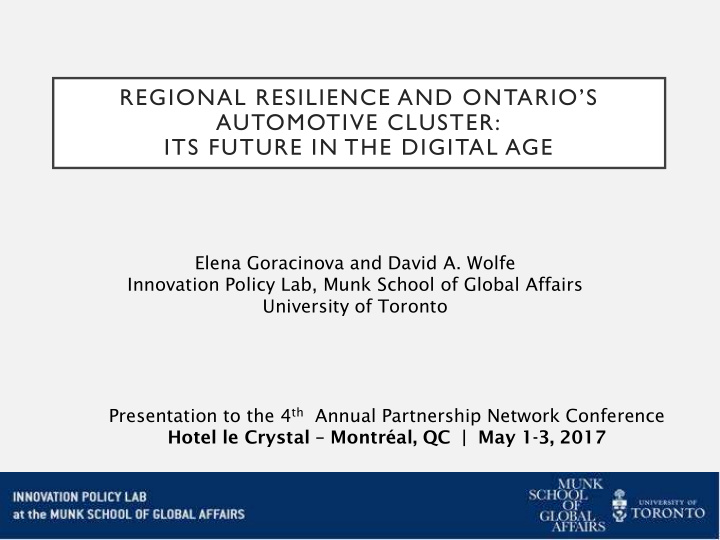



REGIONAL RESILIENCE AND ONTARIO’S AUTOMOTIVE CLUSTER: ITS FUTURE IN THE DIGITAL AGE Elena Goracinova and David A. Wolfe Innovation Policy Lab, Munk School of Global Affairs University of Toronto Presentation to the 4 th Annual Partnership Network Conference Hotel le Crystal – Montréal, QC | May 1-3, 2017
Source: PriceWaterhouseCoopers (2013). Annual data compiled by Statistics Canada (2015)
AGENDA Why the increase in multinational enterprise (MNE) automotive R&D outside of traditional locations? Use EEG theory to identify factors behind why Ontario is chosen as a source of scientific/technical expertise. What is driving change in the Ontario automotive cluster? Case studies Data
I. MNE’S & REGIONAL DEVELOPMENT Relations between parent MNE’s & subsidiaries in host locations are changing MNE’s becoming mechanism for creating new technologies in discrete regional contexts Cantwell and Mudambi (2011)
Framework for linkages of MNE R&D units Type of linkages Degree of linkages Closely in contact with the MNCs HQs, report to parent unit/ can signal long term high Wholly owned R&D unit commitment to local economy Joint research Collaborative projects with local organizations/ require high degrees of trust Human resource recruitment, Recruitment of human resources and education education, training low Arm’s length Informal or one off interactions Patra and Krishna (2015)
GROWING DETROIT-SOUTHWEST ONTARIO CLUSTER LINKAGES Figure 1. Detroit automakers and geographical dispersion of patent connections Harvard Patent Network Dataverse; Hannigan et al. 2015 Figure 2. Technological composition of Detroit patents connected to SW Ontario
II. PATH DEPENDENCY & REGIONAL RESILIENCE “New paths do not emerge in a vacuum, but always in the contexts of existing structures and paths of technology, industry and institutional arrangements” (Martin & Simmie 2008, 186) B. Ontario’s knowledge C. Supply chain A. Path Dependence? infrastructure/ strengths skilled labor
A. powertrain ASIP Provincial automotive R&D Spending materials and manufacturing 1600 connectivity 1400 1200 1000 800 600 400 200 materials and AIF 0 2004-2009 2009-2014 manufacturing Automotive Sector Specific Cross Sector powertrains, fuels and emissions production capacity Federal automotive R&D spending 1600 Table 3. Plant Managers’ assessment of the degree to which selected public policies inhibit or contribute to 1400 plant success 1200 1000 health, safety and injury 800 prevention 600 societal issues 400 materials and 200 manufacturing 0 powertrains, fuels and Holmes et al. (2017) 2001-2008 2008-2015 2015-2020 emissions Automotive Specific Cross Sector
Number of automotive researchers B. 600 500 400 300 200 100 0 2000 2004 2017 capabilities Basic Contract services research U of Ottawa U of Waterloo U of Windsor McMaster U Toronto Western U
Source: Statistics Canada, 2014; CANSIM Table C. 379-0030. 2004 2009 % of 2013 %2004 2004 Engines and engine $1,902,600,000 $1,146,900,00 60% $1,361,400,00 72% parts 0 Electrical and $299,200,000 $115,100,000 38% $385,400,000 129% Electronic Steering and $447,000,000 $264,200,000 59% $432,700,000 97% Suspension Wheels and Brake $402,200,000 $185,700,000 46% $131,300,000 33% Systems Transmission and $1,135,900,000 $445,400,000 39% $761,100,000 67% Powertrain Seating and Interior $1,384,100,000 $681,800,000 49% $857,500,000 62% Metal Stamping $1,557,500,000 $797,900,000 51% $1,405,800,000 90% Other $1,734,500,000 $896,500,000 52% $1,651,100,000 95%
III. CASE STUDIES
GM Partnered with 9 research institutions in Ontario Communitech Innovation Near IT cluster built around Research Zone R&D IBM Research GMC collaboration Center for Canada Automotive New with Automotive Research Technical Center of Engineering Fraunhofer Materials Chair in Centre Excellence and Software Project Center and Advanced Attempts to establish Cold (UOIT) Development (Western U) Corrosion Materials Automotive Innovation Weather Center (McMaster) (Waterloo Network Testing (Markham) U) 1973 2017 2005 2001 2008 2012 2015 2016 Maven New investment in Cold Weather Testing GM Ventures Facility GM-Sapa R&D New mandate for the Canada Technical Exco Supply chain collaboration Centre Technologies Project Beacon (2.5 billion, more than 400 million in gov. money) Joins Automotive Partnership Industry Task Force/ PACE Partner
FORD Partnered with 7 research Ford Centre for institutions in Ontario Excellence in Manufacturing at St. Auto21 Clair College in U of T Ford Windsor Powertrain Fumes to Fuel Research 295 employees Engineering and Technology and Research and transferred from Collaboration Research Research Centre at Blackberry engineering Research Development the Oakville center in Centre (Windsor) collaboration assembly plant Clean Diesel Ottawa, with (internal expertise + Engine Research additional Fraunhofer Laboratory Queens University + locations in Project University of (University of Waterloo and Center Windsor) Alberta) Oakville (Western U) 1990 2017 2003 2009 2012 2017 Oct Expansion of powertrain and ANAC/FORD research Nemak Engineering Center (2017) partnership Ontario BioCar (universities and suppliers partake) Initiative (U of Waterloo, U of Guelph, U of Windsor, U of Supply Toronto) chain Renaissance project 730 million (80 million from AIF) Automotive Innovation Fund (102,4 million) UNIFOR secured 713 million in investment
OTHER MNE PRESENCE Powertrain University of Partnership Toyota/Unive Windsor/Chrysler McMaster/Chrysl rsity of Canada Automotive er Partnerships Waterloo Research and (working in (Toyota, Development Centre conjunction with Cambridge + Collaborative Research (30 million) Chrysler’s Toyota Centre Apple Nissan Global Technical Toyota/University of (Kanata) Infiniti Lab Electrified Center in Ann Toronto Toronto Powertrain Arbor) Group) 1996 2017 2013 2014 2016 University of Windsor/Chrysler Canada Automotive Research and Development Centre (600 million) Automotive Partnership Canada/NSERC Relevance of global knowledge pipelines
IN CONCLUSION Increased automotive R&D integration in the Great Lakes not only driven by the presence of technological expertise, but by historical relationships and activist policy. Future research: Unpack the creation of R&D partnerships in more detail Quantify types of MNE R&D linkages in Canada Trace US patents back to innovators in Canada and their affiliations Introduce a comparator case
Recommend
More recommend